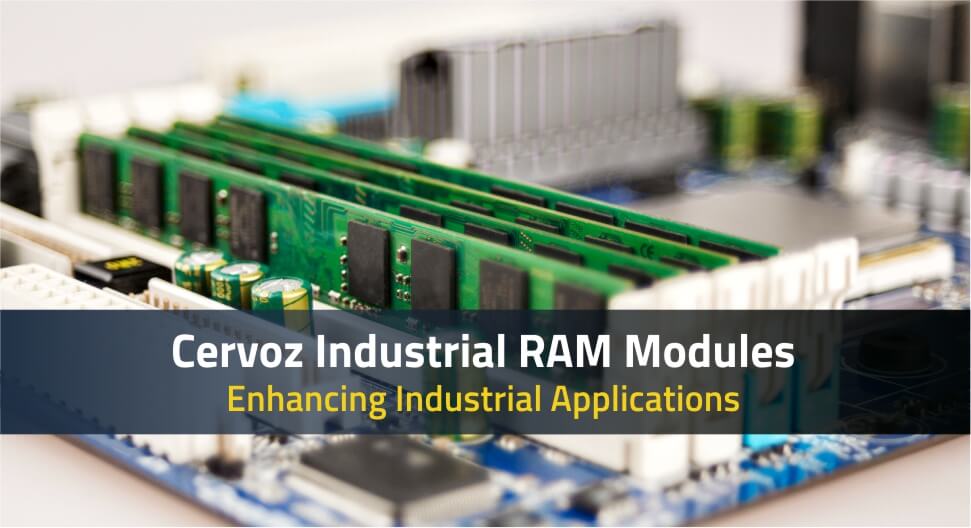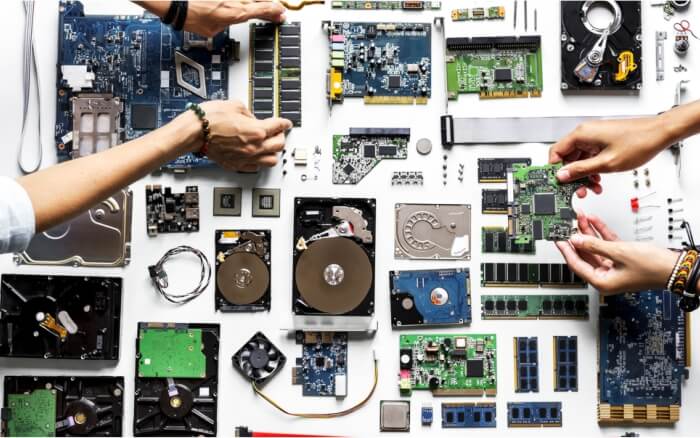- Company
- Press Center
- Cervoz Industrial RAM Modules: Enhancing Industrial Applications
BLOG
2023.12.13
Cervoz Industrial RAM Modules: Enhancing Industrial Applications
SHARE

Industrial memory is a pivotal enabler upholding nonstop operations in environments where commercial-grade components falter. Unlike mainstream memory, industrial RAM chips and modules endure extreme temperatures, continuous vibrations, shocks, humidity, and other punishing conditions endemic to factories, energy plants, transportation hubs, and mining facilities. By withstanding such settings, specialized industrial RAM empowers the vital data processing, storage, control, and analytics necessary to keep assembly lines running, prevent power grid failures, avert train collisions, and sustain extraction.
This article will delve into the crucial aspects of industrial RAM modules, emphasizing the unique characteristics that set them apart from regular consumer-grade memory modules. We will also spotlight Cervoz, a leading player in the field, and explore how their industrial DRAM modules cater to the demanding needs of industrial applications.
Industrial Applications of RAM
RAM (Random Access Memory) is critical in industrial settings for several key reasons. Unlike long-term storage devices like hard drives or SSDs, RAM is a volatile memory type that temporarily holds data for quick CPU access. It serves mainly to improve operational efficiency by acting as a high-speed workspace for the CPU, a feature vital for real-time data processing, automation, and control systems in industries such as manufacturing and smart infrastructure.
High-Speed Data Processing
Industrial RAM enables rapid calculations crucial for real-time control and analytics. In automotive plants, for instance, it quickly turns large sets of sensor data into actionable insights, improving system performance. It also speeds up AI and machine learning algorithms essential for predictive maintenance.
Robust Data Storage
Unlike traditional hard disk drives, which are prone to failure in harsh industrial conditions, RAM's solid-state nature makes it more resilient, serving as a reliable short-term data buffer.
Data Flow Buffering
RAM holds data packets temporarily to synchronize devices that operate at different speeds, preventing data bottlenecks and ensuring smoother data flows.
Quick Program Execution
In Programmable Logic Controllers (PLCs), code from non-volatile flash memory is loaded into RAM for fast execution. This enables quick program updates, critical for maintaining real-time performance.
Different Types of RAM
There are three primary types of RAM: DRAM (Dynamic Random Access Memory), SRAM (Static Random Access Memory), and SDRAM (Synchronous Dynamic Random Access Memory). Each type has unique features, speed, volatility, and suited use cases.
DRAM (Dynamic Random Access Memory)
DRAM is the most common type of RAM used in consumer and industrial applications. It is characterized by its high density and relatively lower cost per bit. However, it is volatile memory, requiring constant refreshing to maintain data integrity.
SRAM (Static Random Access Memory)
SRAM is faster and more reliable than DRAM but is also more expensive. It does not require refreshing, making it suitable for applications where high-speed access to data is crucial. However, this type of memory requires constant power.
SDRAM (Synchronous Dynamic Random Access Memory)
SDRAM is a type of DRAM that synchronizes data transfers with the CPU's clock speed. This synchronization allows for higher data transfer rates and is commonly used in modern computer systems.
Navigating Through DDR Generations
The evolution of DDR (Double Data Rate) memory plays a significant role in meeting the escalating demands of industrial environments. DDR memory has gone through multiple generations, each offering improved performance and efficiency. These generations include SDR SDRAM, DDR, DDR2, DDR3, DDR4, and the latest DDR5.
Cervoz delivers solutions spanning mature DDR for legacy systems to state-of-the-art DDR5 for tomorrow's applications. The DDR progression has increased transfer rates and capacities while slashing power consumption, latency, and form factors.
SDR SDRAM
SDR SDRAM was invented in 1996 and is used in faster computer models, typically in system memory and video graphics memory. SDRAM is popular for use in modern game consoles and gaming computers because it effectively runs at high speeds.
DDR (1st Generation)
DDR, also known as Double Data Rate Synchronous Dynamic RAM, was invented in 2000. DDR, sometimes referred to as DDR1, modules rated for industrial temperatures simplify replacement and upgrade initiatives across older systems while still fulfilling niche roles.
DDR2 (2nd Generation)
DDR2 is the next upgrade from DDR SDRAM and brought faster speeds and more capabilities than its predecessor. While DDR2’s operating voltages remained unchanged from DDR, this generation nonetheless doubled theoretical bandwidths via increased clock rates and higher module densities suited for mid-2000s applications.
DDR3 (3rd Generation)
DDR3 is popularly used in gaming computers. This DRAM consumes 30% less energy than its predecessors and can transfer data at twice the rate of DDR2. These improvements coupled with DRAM density increases solidified DDR3 as today’s dominant incumbent for high performance at reasonable cost.
DDR4 (4th Generation)
DDR4 is the current standard for modern-day computers. DDR4 is great for games, engineering programs, coding, and video editing software.DDR4 has faster speeds, reduced power consumption, and improved reliability compared to DDR3 and DDR2.
DDR5 (5th Generation)
Hitting the market in 2020, the forthcoming DDR5 dwarfs DDR4 densities, doubles bandwidths, slashes latencies, and incorporates error correction. DDR5 enables industrial applications requiring immense datasets for big data, machine learning, and real-time analytics at the edge.


Features of Cervoz's Industrial DRAM Modules
Cervoz's industrial DRAM modules come with a host of features that make them ideal for industrial applications:
ECC (Error-Correcting Code)
ECC provides indispensable error checking and correction to prevent data corruption. Registered ECC memory, designed for high-load applications, utilizes buffers to secure data stability, accepting marginally higher latency as a trade-off. Unbuffered ECC memory, in contrast, affords reduced latency, benefiting rapid data access but may not sustain the same level of reliability required for consistent performance in demanding industrial operations.
Wide Temperature Range
Most of Cervoz’s memory modules are designed to operate reliably across a broad temperature range, from -40˚C to 85˚C. This is essential for industries like automotive and outdoor telecommunications.
High Shock and Vibration Resistance
Cervoz's DRAM modules can withstand mechanical stresses and vibrations commonly encountered in industrial environments, ensuring data stability.
Longevity and Reliability
These modules have a long lifecycle, reducing the need for frequent replacements and minimizing downtime.
Cervoz's Industrial DRAM Modules: A Future Outlook
Industrial systems require resilient memory engineered for extreme environments, continuous uptime, and perpetual operation. Cervoz's Industrial DRAM Modules are purpose-built for the demanding requirements of industrial settings, ensuring reliability and peak performance for critical systems. With a commitment to innovation and quality, we continuously adapt to industry needs, providing memory solutions that enhance operational efficiency.
Our reliable memory solutions thrive in harsh industrial conditions, making them indispensable for various critical applications. If you are searching for memory solutions that can withstand the harshest industrial environments, we invite you to explore Cervoz's Industrial DRAM Module product line.

